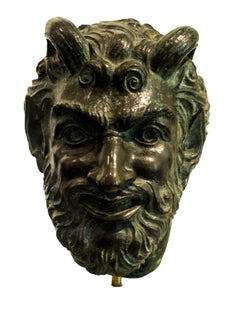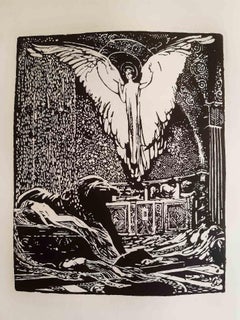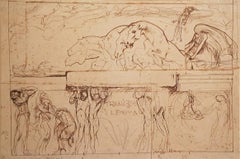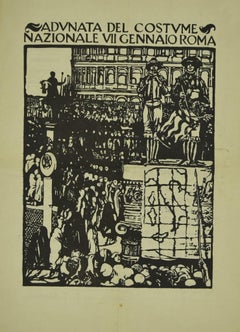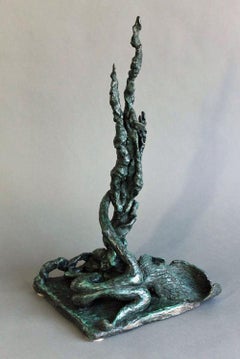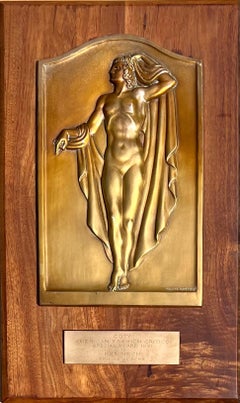Giulio Aristide Sartorio Art
Italian, 1860-1932
Giulio Aristide Sartorio was an Italian painter and film director from Rome. Alongside the activity of landscape artists who saw him, in 1904, he was also among the promoters of the XXV group of the Roman Campagna. He also had numerous public commissions like the famous decorative frieze for the new parliament hall (1908–12), which merges literary inspiration with refined design elegance.
to
3
1
Overall Width
to
Overall Height
to
4
1
1
1
3
3
3
2
1
1
1
1
1
1
1
1
1
1
1
1
1
4
9,514
2,688
1,375
1,361
4
Artist: Giulio Aristide Sartorio
Satiro - Original Bronze Sculpture by Giulio Aristide Sartorio
By Giulio Aristide Sartorio
Located in Roma, IT
Bronze head sculpture realized by Giulio Aristide Sartorio, an Italian painter, sculptor and film director from Rome.
Having attended the Rome Institute of Fine Arts, Sartorio presented a Symbolist work at the 1883 International Exposition of Rome. He made friendships with Nino Costa and Gabriele D’Annunzio, and associated with the painters and photographers of the Roman countryside.
His period of greatest renown came at the beginning of the century, when he produced decorative friezes for the 5th Esposizione Internazionale d’Arte of Venice (1903), the Mostra Nazionale of Fine Arts (Milan, Parco Sempione...
Category
Early 20th Century Modern Giulio Aristide Sartorio Art
Materials
Bronze
Sibilla - Original Rare book Illustrated by Giulio Aristide Sartorio - 1922
By Giulio Aristide Sartorio
Located in Roma, IT
Sibilla is an original couple of books engraved by Giulio Aristide Sartorio (Rome, 1860 - 1932) in 1922.
Original First Edition.
1333 numbered and signed copies.
Published by L'Eroica, Milan.
Format: in 4°. The dimensions of the book are indicative.
The book includes 230 pages with 219 etchings (70 of them are in full page).
Good conditions.
Giulio Aristide Sartorio (11 February 1860 – 3 October 1932) was an Italian painter and film director from Rome. Having attended the Rome Institute of Fine Arts, Sartorio presented a Symbolist work at the 1883 International Exposition of Rome. He formed friendships with Nino Costa and Gabriele D’Annunzio, and associated with the painters and photographers of the Roman countryside. He won a gold medal at the Paris Universal Exhibition of 1889 and met the Pre-Raphaelites in England in 1893. His participation in the Venice Biennale began in 1895 with the 1st International Exposition of Art of Venice, after which he taught at the Weimar Academy of Fine Arts from 1896 to 1898. His period of greatest renown came at the beginning of the century, when he produced decorative friezes for the 5th Esposizione Internazionale d’Arte of Venice (1903), the Mostra Nazionale of Fine Arts (Milan, Parco Sempione...
Category
1920s Symbolist Giulio Aristide Sartorio Art
Materials
Paper
Sketch for the Parliament Hall “Thanatos and the Enigma” - 1900s - Drawing
By Giulio Aristide Sartorio
Located in Roma, IT
Original drawing, pencil on paper. A wonderful sketch for the frieze for Parliament Hall in Montecitorio Palace, in Rome.
Good conditions except for a diffused foxing, including a w...
Category
Early 1900s Modern Giulio Aristide Sartorio Art
Materials
Ink
Gathering of the Costume - Woodcut by G.A. Sartorio -1938
By Giulio Aristide Sartorio
Located in Roma, IT
Gathering of the Costume is a woodcut print realized by Giulio Aristide Sartorio in 1938.
The album composed of 10 pages, was realized for the Royal wedding of King Umberto of Savoy...
Category
1930s Modern Giulio Aristide Sartorio Art
Materials
Woodcut
Related Items
Woman Lying Down & Growing with Tree bronze sculpture by Yulla Lipchitz
Located in Hudson, NY
Organic, abstract bronze sculpture by Yulla Lipchitz of a woman lying down with a tree.
About this artist: Yulla Lipchitz, née Halberstadt, was born on April 21, 1911 in Berlin, Ge...
Category
1970s Modern Giulio Aristide Sartorio Art
Materials
Bronze
$3,775
H 16 in W 7 in D 8 in
1961 Coty Award Plaque Kenneth Hairdresser Jacqueline Onassis Bronze Fashion
Located in New York, NY
1961 Coty Award Plaque Kenneth Hairdresser Jacqueline Onassis Bronze Fashion
Bronze on wood. The wood plaque measures 12 3/4" by 20 3/4 inches. The bronze plaque itself is 13 3/4 x 8 3/4 inches and the the bronze inscription, which reads "COTY, American Fashion Critics Special Award 1961 to KENNETH of LILY DACHE...
Category
1960s American Modern Giulio Aristide Sartorio Art
Materials
Bronze
Rancho Woodcut Heart, 1982
By Jim Dine
Located in Palo Alto, CA
One of Jim Dine’s most iconic motifs, the romantic Rancho Woodcut Heart work illustrates the story of hope and love through a symbolic image of a large red heart. With the contrast o...
Category
1980s Modern Giulio Aristide Sartorio Art
Materials
Woodcut
Painting and etching 70x50 cm, Chahab, 2N Gallery New York
Located in Riga, LV
Painting and etching
70x50 cm, Chahab, 2N Gallery New York
Category
21st Century and Contemporary Modern Giulio Aristide Sartorio Art
Materials
Paper, Printer's Ink
$170 Sale Price
20% Off
H 27.56 in W 19.69 in D 0.04 in
Wedding Party
Located in Buffalo, NY
An original mid century modern woodblock print.
This work is hand signed illegibly and titled "Wedding Party".
Category
1960s Modern Giulio Aristide Sartorio Art
Materials
Paper, Woodcut
David Hostetler Polished Bronze Female Form Bust Feminine Shiny Gold Egyptian
By David Hostetler
Located in Nantucket, MA
This polished bronze bust is sealed with Glasurit- a car finish that is baked on. It prevents the sculpture from tarnishing or yellowing. All you need to do is dust with a soft cloth. This bust is from a full figure wood sculpture...
Category
1970s Modern Giulio Aristide Sartorio Art
Materials
Bronze
$5,900
H 11.5 in W 7 in D 4 in
Elwood W. Bartlett, Wisconsin Farm, about 1945, mid-century wood engraving
Located in New York, NY
Elwood Warren Bartlett is a Wisconsin native who also worked in Indiana.
Largely self taught as a printmaker, Bartlett worked in a style that once identified as his, immediately t...
Category
1940s American Modern Giulio Aristide Sartorio Art
Materials
Woodcut
Stevan Dohanos, Backyard
By Stevan Dohanos
Located in New York, NY
Stevan Dohanos was an accomplished draftsman who work was widely known through the Saturday Evening Post. This print 'Backyard,' however, leaves aside the illustrative magazine work ...
Category
1930s American Modern Giulio Aristide Sartorio Art
Materials
Woodcut
"Nativity" Modernist Landscape Screen Print in Ink on Paper -
Located in Soquel, CA
"Nativity" Modernist Landscape Screenprint in Ink on Paper
Whimsical modern landscape silkscreen print of the nativity scene by San Francisco, C...
Category
1970s Modern Giulio Aristide Sartorio Art
Materials
Paper, Printer's Ink, Screen
$452 Sale Price
20% Off
H 10.5 in W 12.25 in D 1.25 in
Werner Drewes, Winter, 1933, modernist woodcut
By Werner Drewes
Located in New York, NY
A modernist fantasy winter scene created by Werner Drewes, this print brings key aspects of the period together. His cubist-inspired woodcut technique is utilized here to bring the s...
Category
1930s American Modern Giulio Aristide Sartorio Art
Materials
Woodcut
Morris Brose "Bronze Bull" Figurative Sculptural Abstract
Located in Detroit, MI
"Bronze Bull" is an exquisite example of Morris Brose's abstract/figurative sculpture. No soft edges on this piece and no invitation to caress, the power, strength and beauty of the bronze are front and center and create awe. "Bronze Bull" is a free-standing piece signed on the base.
Morris Brose, Polish/American was born in Wyszkow, Poland. He became a sculptor and instructor of sculpture at the Detroit Institute of Arts, Wayne State University and Cranbrook Academy of Art, Bloomfield Hills, Michigan. Cranbrook was designed by architect and faculty member, Eliel Saarinen who collaborated with Charles and Ray Eames on chair and furniture design. Numerous creative artists who are alumni of Cranbrook include: Harry Bertoia, Florence Knoll, Jack Lenor Larsen, Donald Lipski...
Category
Late 20th Century Modern Giulio Aristide Sartorio Art
Materials
Bronze
$5,500
H 26.5 in W 16 in
Large Gilt Bronze Sculptures of Cheetahs
Located in Rome, IT
Fantastic pair of gilt bronze Cheetahs sculptures . The item will be well-suited to either an indoor or outdoor setting.
Category
Early 2000s Modern Giulio Aristide Sartorio Art
Materials
Bronze
Giulio Aristide Sartorio art for sale on 1stDibs.
Find a wide variety of authentic Giulio Aristide Sartorio available for sale on 1stDibs. You can also browse by medium to find art by Giulio Aristide Sartorio in bronze, ink, metal and more. Much of the original work by this artist or collective was created during the 20th century and is mostly associated with the modern style. Not every interior allows for large Giulio Aristide Sartorio, so small editions measuring 6 inches across are available. Customers who are interested in this artist might also find the work of Antonio Donghi, Yasuo Kuniyoshi, and Giovanni Pintori. Giulio Aristide Sartorio prices can differ depending upon medium, time period and other attributes. On 1stDibs, the price for these items starts at $1,393 and tops out at $27,851, while the average work can sell for $5,093.
